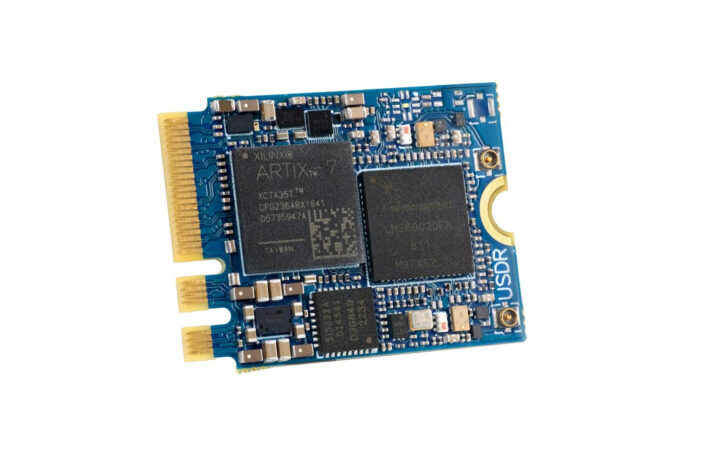uSDR is an embedded software-defined radio (SDR) M.2 board based on an AMD Embedded Artix-7 FPGA and designed to be controlled in the Chrome, Opera, or Edge browser without specific drivers or software thanks to WebUSB technology.
The module can be inserted into any compatible host, or through M.2, USB, mini PCIe or PCIe adapters, and used from a web browser with ready-to-use applications such as a spectrum monitor or a signal analyzer, or your own JavaScript, C/C++, Rust, Go, or C# application thanks to WebAssembly and the Emscripten project.
uSDR specifications:
- RFIC – Lime Microsystems LMS6002D programmable RF (FPRF) transceiver IC operates from 300MHz to 3.8GHz
- FPGA – AMD Embedded XC7A35T (Artix-7) FPGA with 33,280 logic cells
- Full-duplex TX & RX
- Frequency range – 300 – 3700 MHz (usable range typically starts from 230 MHz)
- RX/TX Bandwidth – 0.75 – 28 MHz plus bypass mode
- Clock generator – SI5332A
- Clock stability – 0.5 PPM
- Sample rate up to 30.72 Msps (40+ Msps in bypass mode)
- Antenna connectors – MHF4 RF connectors
- USB – USB 2.0 @ 480 Mbps, streaming ~15 Msps half-duplex or ~5-6 Msps full-duplex
- Host interface – PCIe or USB via M.2 2230 Key A+E interface
- Power supply range – 2.85 – 5.5 V
- Dimensions – 30 x 22 x 2 mm (M.2 2230 module with components on only one side of the PCB)

If your host doesn’t have an M.2 2230 A- or E- key interface, the company can provide B-Key or M-Key adapters, a USB Type-A or Type-C adapter, mini PCIe adapters, or even a PCIe adapter through a development board.
On the software side, WSDR, the web-based SDR platform, is an extensible framework upon which you can run applications and comprised of three layers:
- Low level – Libraries for basic DSP functions, data manipulation, and hardware abstraction
- The platform level – APIs for various services like configuration, data sharing, data storage, offloading intensive processing tasks, etc.
- The application level – Where you define your data pipeline, data visualizations, and visual control blocks.
The company behind the project – Wavelet Lab – has also developed several ready-to-use applications to quickly get started: a spectrum monitor, a signal analyzer, a PMR receiver, an IQ playback application, an IQ recorder, and an IQ signal generator.

The project is open-source hardware, and eventually the Altium hardware design files, FPGA gateware, PCIe Linux kernel driver, and all WSDR code will be released publicly.
Wavelet Lab has launched the uSDR M.2 SDR module on Crowd Supply with a $109,987 funding target. Rewards start at $299 for the uSDR module only, and goes up to $997 for the uSDR Early Adopter Kit that comes with an uSDR module, three adapter boards, a PCIe development board, antennas, and other accessories. Shipping is free to $8 to the US depending on the selected perk, and $18 to the rest of the world. The early adopter kit is scheduled to ship at the end of November 2023, and the other rewards at the end of February 2024.

Jean-Luc started CNX Software in 2010 as a part-time endeavor, before quitting his job as a software engineering manager, and starting to write daily news, and reviews full time later in 2011.
Support CNX Software! Donate via cryptocurrencies, become a Patron on Patreon, or purchase goods on Amazon or Aliexpress





